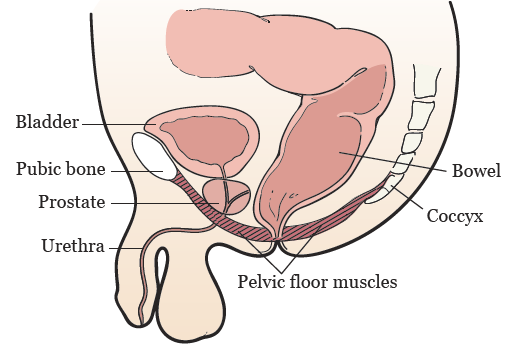Top 13 Exercises for Strengthening Pelvic Muscles
Introduction
Exercises for strengthening the pelvic muscle are referred to as pelvic muscle training exercises.
Exercises for strengthening the pelvic muscles are advised for:
- Urinary stress incontinence in women
- Urinary stress incontinence in men, typically following prostate surgery
Those who are incontinent of their feces - Exercises targeting the muscles beneath the uterus, bladder, and gut (large intestine) can help build stronger pelvic floor muscles.
- They can assist both sexes who struggle with bowel control or urine leaks.
- An exercise for strengthening the pelvic floor involves retaining your bladder while acting as though you need to urinate.
- The muscles that regulate pee flow are contracted and relaxed.
- It’s critical to identify which muscles to tense.
- Start, then stop, the next time you need to go to the bathroom.
- Sensation the muscles in your anus, bladder, and vagina tighten and lift.
- The muscles of the pelvic floor are these.
- You’ve performed the exercise correctly if you feel them tighten.
- Don’t make it a habit to perform the exercises while having a pee.
- Once you can recognize the muscles with ease, work on the exercises while seated—DO NOT do the exercises while you’re urinating.
- Remember that all of the pelvic floor muscles contract and release simultaneously if you are still unsure if you are contracting the correct muscles.
The rectum and bladder are all controlled by these muscles, thus the following advice can be useful:
Ladies
- Stick your finger inside your Rectium.
- As though you were holding pee, tense your muscles, then relax.
- The muscles should contract and contract again.
Guys
- Stick your finger inside your rectum.
- As though you were holding pee, tense your muscles, then relax.
- The muscles should contract and contract again.
- The muscles you would tense in order to stop yourself from passing gas are the same ones.
- Pelvic floor muscles are crucial for sexual function and help control the uterus, bladder, and intestine.
- The aging process, weight, childbearing, and even persistent coughing can weaken these muscles.
- A person may therefore have pelvic organ prolapse, incontinence, or even painful sex.
- For certain individuals, pelvic floor muscle (PFM) treatment may be a useful alternative to help relieve these adverse effects.
- Apurva B. Pancholy, MD, a urogynecologist at UT Physicians and an assistant professor in the Department of Obstetrics, Gynecology, and Reproductive Sciences at McGovern Medical School at UTHealth Houston, clarified that pelvic floor muscle therapy is a non-invasive and generally low-risk treatment.
- This is often our first choice when treating individuals with pelvic floor issues.
- PFM treatment, in its most basic form, consists of exercises done at home.
13 Exercises for Strengthening Pelvic Muscles
Following are the best exercises to strengthen your pelvic muscle
Kegels
By tensing and releasing your pelvic floor, kegel exercises are an excellent method for strengthening your pelvic muscles.
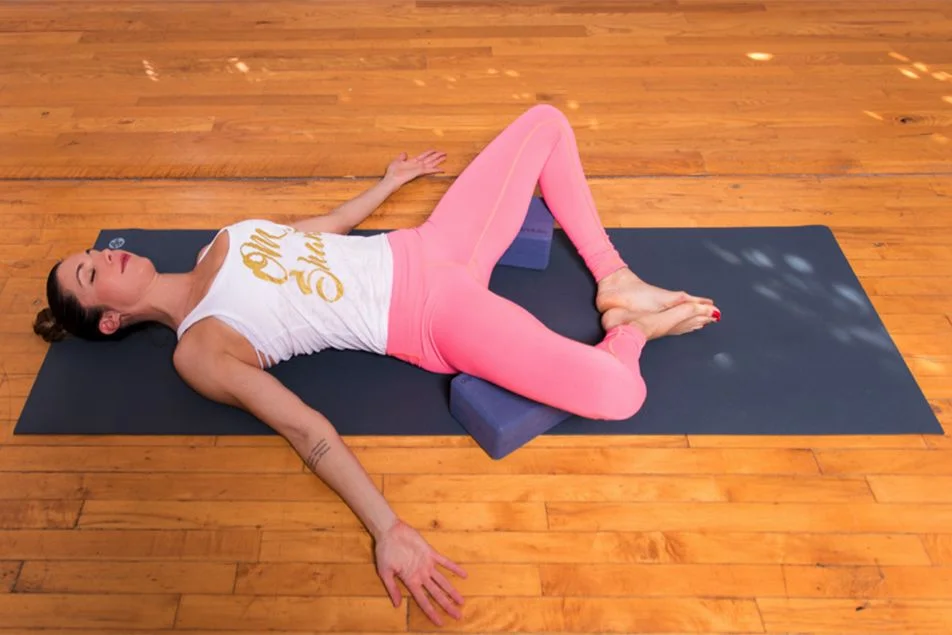
Steps To Follow:
- Breathe normally throughout while you identify and contract your pelvic floor muscles with a lift and squeeze action.
- Try to hold the lift and squeeze motion for a maximum of ten seconds.
- Before doing another set, completely relax your pelvic muscles.
- To finish a full set of this exercise, you can perform up to 12 repetitions consecutively.
- The objective is three sets every day.
Bridge

Although most people believe that the bridge is a fantastic glute workout, it may also assist in strengthening the muscles in your pelvic floor.
Steps To Follow:
- With your knees bent 90 degrees and your back flat against the floor, assume a floor position.
- With your arms by your sides and your palms facing downward, position your feet flat on the ground.
- Lift your hips off the floor by pushing through your heels and contracting your hamstrings, pelvic floor, and glutes.
- After a little pause, go back to the starting position.
Bird dog

The bird dog pose works your pelvic floor and several other muscle groups in your body.
Steps To Follow:
- Place your wrists beneath your shoulders and your knees under your hips while on your hands and knees.
- Ensure that your back is as straight as it can be.
- Pull your shoulder blades back down toward your hips while bracing your core muscles.
- Keep the rest of your body neutral while you simultaneously raise and straighten your right arm and left leg.
- Hold on for a while.
- Return your leg and arm to their starting positions.
- Utilizing the opposing extremities, repeat the motion.
Squeeze and release
The swift movement facilitates a prompt response from the pelvic floor muscles.
Steps To Follow:
- Choose a comfy spot to sit.
- Imagine the muscles of the pelvic floor.
- Release them as soon as you can, without attempting to retain the contraction.
- Take a 3–5 second break.
- Do this 10–20 times for each set.
- Later in the day, perform two sets.
Squats
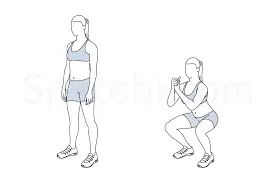
Squats may help strengthen children’s buttocks and pelvic floor, according to some studies.
But one should only begin squatting for this reason if they are experienced performing Kegels in a bridge or fixed posture.
Steps To Follow:
- Maintaining your feet level on the ground, place them hip-width apart.
- Bend at the knees and bring your buttocks as close to the floor as comfortable.
- Maintain a straight back and a small forward tilt.
- The knees and toes should line up.
- When you stand back up, concentrate on contracting your pelvic floor and buttocks.
- Perform up to ten repetitions of this exercise in a set.
- Take a break before attempting any more sets.
Note: But not every squat works the pelvic floor.
It may be difficult to maintain a pelvic floor contraction in deep or wide-legged squats.
Narrow and shallow squats are often more advantageous for strengthening the pelvic floor.
Seated Breathing
Although it may seem easy, Treacy suggests that you choose a comfortable seat and breathe deeply into your side ribs to facilitate the diaphragm and pelvic floor muscles to expand.

Steps To Follow:
- Imagine that as you breathe in, a fish’s gills spread out to the sides to allow it to take in air.
- The pelvic floor and diaphragm stretch as you perform this.
- Feel the pelvic floor gently lift as you fully release the breath and the ribs return to their center.
- Take eight or ten more breaths.
Runner’s Lunge
According to Treacy, this stretch lengthens the deep abdominal muscles that are located in the pelvic bowl as well as all of the muscles in the front of the back leg.

Steps To Follow:
- With one foot placed front, place the knee over the ankle and let the rear knee drop to the floor.
- Now frame your front foot with two hands.
- Put your hands on two yoga blocks that are standing on their longest sides if they are difficult to reach the floor.
- If you don’t have yoga blocks, you may build a suitable height by piling books on top of one another.
- Allow your hips to go forward, exposing the thigh of your rear leg.
- Aim to place your front knee exactly over your ankle.
- Take 12 to 15 deep breaths and hold.
Side Lunges

By opening the inner thighs, a side lunge facilitates pelvic floor lengthening.
Steps To Follow:
- Place your feet approximately the width of your leg apart.
- Bend into a single knee while keeping both heels firmly planted on the ground.
- Touch the floor with your hands or place them on yoga blocks.
- Toes pointing upward, maintain the opposite leg straight and externally spin it from deep within the hip socket.
- After eight breaths of holding, turn sides and repeat each one once more.
Hamstring Stretch
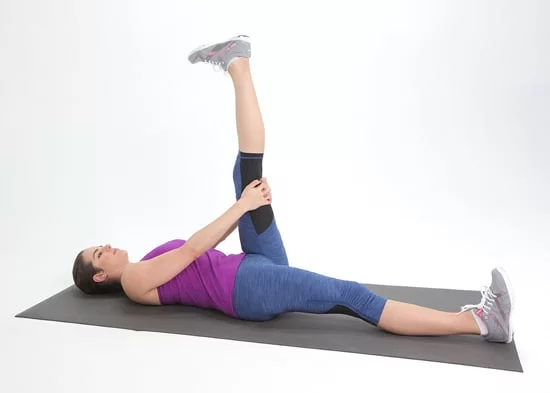
possess taut glutes? This stretch helps to stretch the deep pelvic floor muscles because it opens out the entire back of the leg from the bottom of the butt to the heel of the foot.
Steps To Follow:
- Assume an all-fours position, keeping your hands flat on two yoga blocks at your sides and your hips aligned with your knees.
- Flex your foot after extending one leg straight out in front of you.
- Make sure your spine does not round out by keeping your back leg hip squarely over your back knee.
- To increase stability and deepen the stretch, apply pressure with your hands on the blocks.
- For ten to twelve deep breaths, hold this stretch.
Supported Pigeon
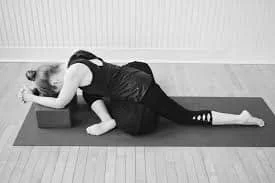
The outer hip muscles that encircle the pelvis will be stretched and lengthened in this restorative yoga posture, according to Treacy.
Steps to Follow:
- A folded blanket or a yoga bolster should be placed perpendicular to a yoga mat.
- Just in front of the bolster, place the front leg shin.
- The inner thigh rolls upward toward the ceiling while the rear leg stretches straight back from the hip.
- As deeply as your body will safely allow, fold over your front leg, being sure to soften and relax in this position.
- Place your head and body on another pillow or pile of blankets if you find this to be too much to stretch.
- “The muscles will grip and you won’t be strengthening your pelvic floor muscles if you can’t let go in this pose,” says Treacy.
- After 10 to 15 breaths, hold this stretch, then swap sides.
Glute Bridges

In yoga, bridge posture opens the chest, engages the pelvic muscles, and strengthens the glutes to facilitate deeper inhalations.
Steps to follow:
- With your knees bent, feet flat on the ground, and hands by your sides, palms down, assume a supine position.
- Lift your butt off the ground by pressing your hips upward and contracting your glutes and pelvic muscles.
- To avoid causing your lower back to arch, make sure your hips are not raised too high.
- At the peak, take a few breaths, and then lower your butt back to the mat. Perform eight to twelve repetitions.
Pelvic Tilt
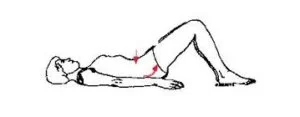
Pelvic tilt exercise improves hip mobility and reduces lower back discomfort during pregnancy and delivery by strengthening the muscles of the lower back and core.
By including a stability ball in the exercise, you may target your pelvic floor muscles and dig deeper into your abs.
Steps To Follow:
- Sit with a tall spine and both feet flat on the floor, beginning on a stability ball.
- When you exhale, extend your glutes and arch your back.
- Inhale while tilting your pelvic floor forward.
- Take a pause midway through the 20 repetitions of tucking and untucking your pelvis.
Deep squat
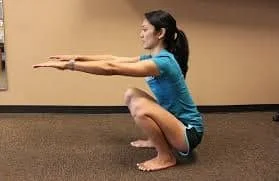
Squats improve the pelvic floor in addition to strengthening the glutes, core, quadriceps, and hamstrings; this is especially true when combined with kegel exercises and certain breathing methods.
Steps To Follow:
- Toes pointed forward or slightly outward, position yourself such that your feet are somewhat wider than hip-width apart.
- As though you were trying to tap your butt against a make-believe chair, bend your knees and drop yourself into a squat.
- As you lower yourself into the squat, take a breath; as you come back up, release the breath and clench your pelvic floor to do a kegel.
Why Pelvic Muscle Exercises Matter
- According to Los Angeles-based yoga instructor Karly Treacy, “There’s a greater chance you’ll experience painful intercourse and inability to orgasm if your pelvic floor muscles are too weak or on the flip side, if they’re too tight.
- ” The stronger and more flexible a muscle is, the more likely it is to “fire,” or contract, during an orgasm, according to Treacy.
- Urinary urge incontinence (having strong, frequent wants to urinate), fecal incontinence (leaky feces), and stress incontinence (leaking urine while coughing, sneezing, or laughing) can all be caused by a weak pelvic floor.
- According to Treacy, “there is a close relationship between the pelvic floor muscles and the adductors, which are the inner thighs.” “Tight adductors cause the pelvic floor muscles to be much less elastic.”
- The good news is that you can easily strengthen your pelvic floor using a range of exercises and stretches, such as yoga poses, breathing exercises, and at-home kegel exercises.
- Your muscles will learn how to contract and relax appropriately with these workouts.
- They also have a very restorative effect, allowing you to truly relax and breathe more thoroughly.
- These are Treacy’s favorite exercises for building your pelvic floor.
You must keep the following muscles relaxed while doing pelvic floor muscle training exercises:
- Abdominal
- The anal sphincter muscle, which is deeper in the buttocks, should contract.
- Thigh
- A vaginal cone, a weighted device put into the vagina, is another way a woman can strengthen these muscles.
- To keep the device in place, you then attempt to tighten the pelvic floor muscles.
- Use biofeedback or electrical stimulation to assist in identifying the right muscle group to work if you are unclear if you are performing pelvic floor muscle training correctly.
- One kind of positive reinforcement is biofeedback.
- Electrodes are positioned along the anal region and on the abdomen.
- To track the contraction of the pelvic floor muscles, some therapists implant a sensor in the anus of males and the vagina of women.
- A graph indicating which muscles are contracting and which are at rest will be displayed on a monitor.
- When conducting exercises for pelvic floor muscle training, the therapist can assist in identifying the appropriate muscles.
Performing Pelvic Floor Exercises
Steps To Follow:
- First, let your bladder out.
- Tension the pelvic floor muscles and hold them there for ten counts.
- For the duration of ten counts, fully relax your muscles.
- Perform three to five sets of ten repetitions in the morning, afternoon, and evening.
- These exercises may be performed anywhere and at any time.
- The majority of individuals choose to perform the exercises while seated in a chair or lying down.
- Most individuals start to see some improvement after four to six weeks.
- Up to three months may pass before you see a significant difference.
- While you are prone to leaking (such as while getting out of a chair), consider doing a single pelvic floor contraction after a few weeks.
- A word of caution
- Some believe that by doing exercises more often and with more repetitions, they may accelerate their improvement. On the other hand, excessive exercise can lead to muscular soreness and a rise in urine leakage.
- You’re probably not performing these exercises correctly if you experience any back or abdominal pain.
- Take deep breaths and keep your body relaxed while performing these exercises.
- Verify that you are not contracting the muscles in your chest, thighs, buttocks, or stomach.
- Exercises targeting the pelvic floor muscles have been demonstrated to be highly helpful in improving urine continence when performed correctly.
- Physical therapists with specific expertise in strengthening the muscles of the pelvic floor exist.
- Formal physical therapy is beneficial to many individuals.
Exercises to avoid
If one has a really weak pelvic floor, some workouts could be too challenging for them.
By doing the workouts, you run the risk of further weakening your muscles and developing incontinence.
A person should refrain from performing the following exercises until they have worked on their pelvic floor for several months:
- situps using the legs extended vertically in the air
- using large weights for few repetitions
- lifts with two legs raised.
- Leaping, sprinting, and more vigorous pursuits
Urinating should not be interrupted in order to assess pelvic floor muscle control.
The possibility of incomplete bladder emptying may arise from this, raising the risk of UTIs and other urinary problems.
Whether at all possible, see a physician and a physical therapist to find out whether there are any particular activities you should avoid following surgery or childbirth.
About Your Pelvic Floor Muscles
Your pelvic floor muscles support your pelvic organs and comprise the base of your pelvis.
These are the muscles that go into relaxation when you pass gas, urinate, or go to the bathroom.
These muscles are also used to contain pee and stop it from leaking out.
When to Call Your Healthcare Provider
Contact your medical professional if you:
- Feel worried about the way your bowel, bladder, or sex work.
- These have difficulty using your pelvic floor muscles
- Get sore when performing Kegel exercises.
- struggle to complete Kegel exercises.
- experience discomfort in the pelvis.
- would like a recommendation for a physical therapist with expertise in pelvic health.
Conclusion:
One may strengthen their pelvic floor by walking more, standing up straight, and sitting in the right postures in addition to doing daily pelvic floor exercises. Another option to try is to squeeze the pelvic floor muscles every time you cough, sneeze, or lift something heavy. Incontinence can be avoided and the pelvic floor strengthened as a result.
FAQs
How can the muscles in your pelvis be strengthened?
Take these actions:
First, let your bladder out.
For ten counts, tense your pelvic floor muscles and hold them there.
For the duration of ten counts, fully relax your muscles.
Perform three to five sets of ten repetitions in the morning, afternoon, and evening.
Why do pelvic floor muscles weaken?
The pelvic floor can be hampered by pregnancy, childbirth, prostate cancer treatment, obesity, and the strain of chronic constipation. Problems can arise from changes in the pelvic floor muscles, which can be caused by pregnancy, childbirth, obesity, chronic constipation, or prostate cancer surgery.
Can one be cured of weak pelvic muscles?
Is it possible to cure pelvic floor dysfunction? Thankfully, most cases of pelvic floor dysfunction can be resolved with medication, physical therapy, and biofeedback. Get in touch with a healthcare professional if you begin to exhibit any pelvic floor dysfunctional symptoms.
How much time does it take to build pelvic floor strength?
Within six weeks, if you’re performing your pelvic floor exercises correctly, you should start to see results. This is by no means an exhaustive list! It could take twice as long to notice improvement if your muscles were incredibly weak. Similar to this, some (fortunate) women report improving their pelvic floor muscles in as little as two to three weeks.
Does walking improve the muscles of the pelvic floor?
With steady, progressive training, weak muscles can be strengthened and made to operate at their best again. Mild, regular exercise like walking can also help strengthen your pelvic floor muscles.
How can someone who has weak pelvic muscles exercise?
Strolling. A great method to get some cardiac exercise and fresh air is to go for a power stroll!
Kegels
Bridge
Bird dog
Squeeze and release
Squats
Seated Breathing
Runner’s Lunge
Side Lunges
Hamstring Stretch
Supported Pigeon
Glute Bridges
Pelvic Tilt
Deep squat
References
Pelvic Floor Muscle (Kegel) Exercises for Males. (n.d.). Memorial Sloan Kettering Cancer Center. https://www.mskcc.org/cancer-care/patient-education/pelvic-floor-muscle-kegel-exercises-males
Crna, R. N. M. (2023, May 30). How to do pelvic floor exercises. https://www.medicalnewstoday.com/articles/322720#summary
Three exercises to strengthen your pelvic floor. (2022, June 30). UT Physicians. https://www.utphysicians.com/three-exercises-to-strengthen-your-pelvic-floor/
Pelvic floor muscle training exercises: MedlinePlus Medical Encyclopedia. (n.d.). https://medlineplus.gov/ency/article/003975.htm\
Rabbitt, M. (2023, February 6). 10 Best Exercises to Strengthen Your Pelvic Floor for Great Sex, According to a Trainer. Prevention. https://www.prevention.com/fitness/g20434818/strengthen-your-pelvic-floor/

